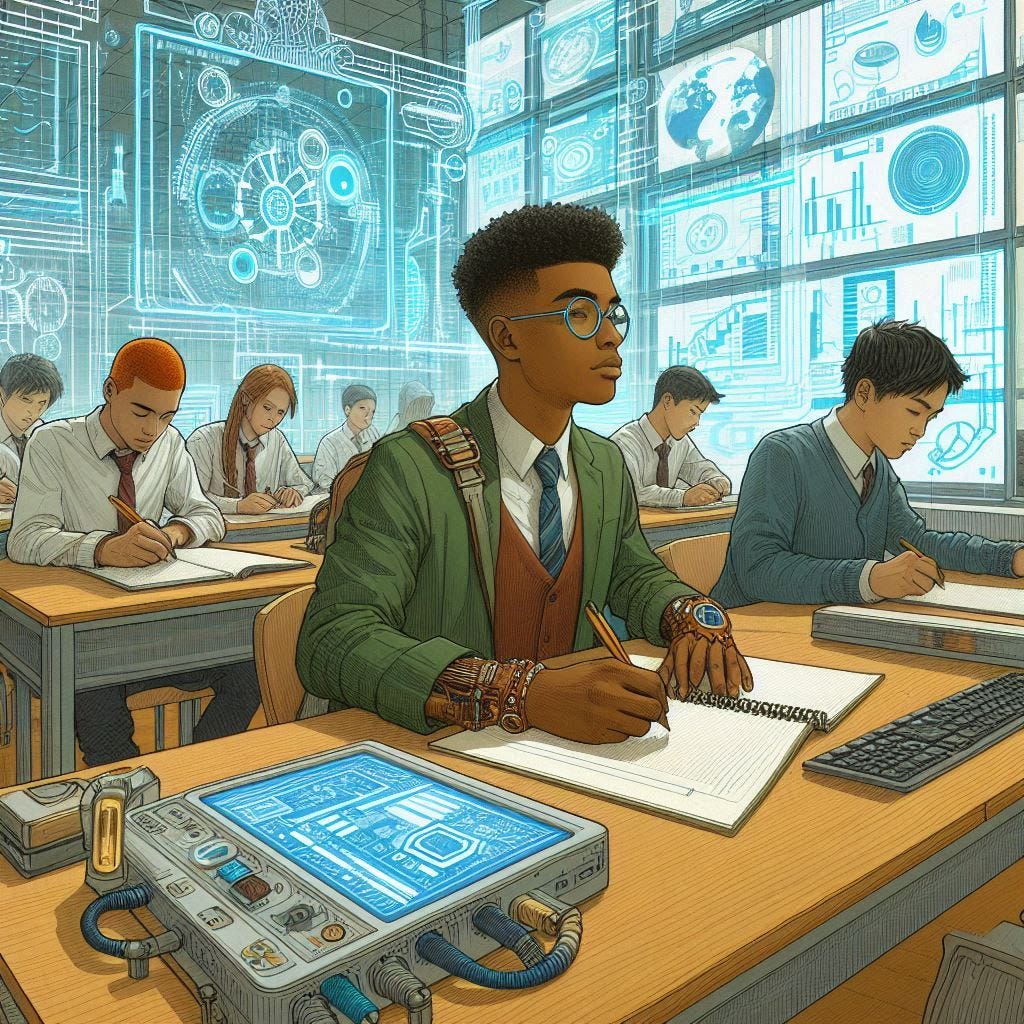Studying the historical archives
The sun shined through into the glass atrium of Esmeralda's majestic academy. The bio-luminescent algae responded to this light by shining in turn, casting the space in a brilliant yellow.
Upstairs however, a group of Advanced Placement students were in the middle of their history class. Ms. Dowling was a seasoned historian with a reputation for his pop culture knowledge. A holographic projection flickered to life behind her.
"Welcome class. Today is your final in-class DBQ," she announced with a warm smile. "Your topic is going to be... a little more modern than our past subjects."
The projection began displaying a series of tweets from the early 2020s. A cacophony of memes, jokes, and hashtags appeared on the screen.
"Ms. Dowling, are these... tweets?"
"Indeed, Janine. These are tweets from the early 2020s, a period of great social and political upheaval. Tweets provide you with a unique opportunity to delve into the unfiltered thoughts of ordinary people living through extraordinary times."
Several tweets appeared on screen, drawing the attention of the students who were unused to this kind of short-text format.
"Guess I should've invested in that underwater condo... #ClimateCrisis #WhoNeedsDryLandAnyway" came from one person only known as @Doomscroller2026. It was posted on January 27, 2026 at 10:14am.
"What does that mean? There's no detail."
"Tweets are short-text. Unlike news articles, you need to infer context from other pieces of history. A catastrophic event happened in January 2026 called the Great Wave, where a tsunami followed an undersea earthquake and devastated coastal cities across the Pacific."
"But this tweet is... it's so flippant," the student said with exasperation. "They're making fun of something so tragic."
"That is the nature of the beast that Twitter used to be," Ms. Dowling responded with a shrug. "Sarcasm and dark humor were coping mechanisms during that time. Just keep in mind these were ordinary people trying to grasp with their anxieties and worries."
The next tweet came from a person called @GangstaGreenThumb, whose picture was a beaver. "Just harvested my glow-in-the-dark radishes. Thanks Bill Gates! #EatYourGreens"
"Glow-in-the-dark radishes?"
"A novelty developed in the 2020s with basic genetic engineering. It was meant to make urban farming appealing to the younger generation. I had my own for a season, until I forgot to water them."
"But why is this person thanking Bill Gates?"
"Yes, that's good question. It's for you to discover."
A third tweet appeared on-screen, from a user named @WaveBae: "Great wave gnarled my home. Crib is soaked, but I'm going to catch some waves with my squad #yolo"
"Crib? Squad?" young Janine puzzled. "This reads like a foreign language."
Ms. Dowling chucked. "That was the slang of the 2020s. Many of the phrases you use today will feel just as strange in a few decades too."
A hush fell over the classroom as they did their best to interpret the strange writings of the past. They were snippets of the human experience, a window into another place and time. They had to focus in order to uncover what they meant.
Hours passed by in a whirlwind as they kept their heads down on reading through these cryptic messages. The students worked in groups huddled around holographic desks, reading and sorting, cross-referencing tweets with historical databases.
Janine spent her time looking at the metadata of each tweet, the timestamps, location, and even devices used for posting. She discovered a pattern over posts surrounding the Great Wave.
Another student, Rahul, had immersed himself in historical gossip and memes. He was enthralled by the cat videos and celebrity fights. But amidst the absurdity of human expression there was a vein of genuine empathy.
As they read a mix of doom and joy, they started seeing the tweets not as isolated fragments of text but small threads which made up a larger narrative. History was more than just grand events occurring in a neat timeline, one after another, enacted by a few famous figures. History happened to ordinary people.
The school day came to an end, and Ms. Dowling brought the group back to retrieve their essays and start a class discussion. The students were buzzing with insights and conjectures. They talked about the power of social media to connect people across distances and cultures, even as those interactions were often hostile.
"The tweets aren't random ramblings," Janine realized. "They help demonstrate the human capacity for adaptation. They show us how we find meaning in the chaos."
"Precisely," Ms. Dowling said with pride. "You've all done an outstanding job, and I look forward to reading your analyses. Remember, history is not a static collection of facts. It's an ongoing conversation between the past, the present, and the future. It's up to us to decipher the messages and slang in order to uncover the hidden truths."


